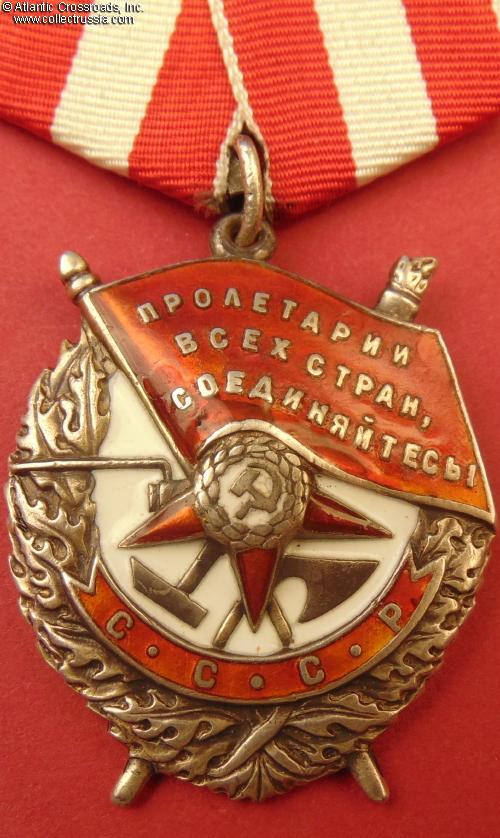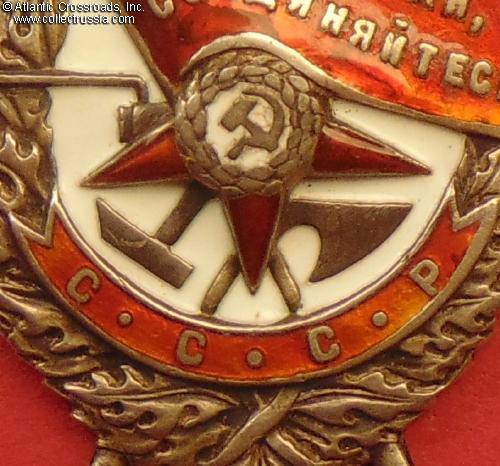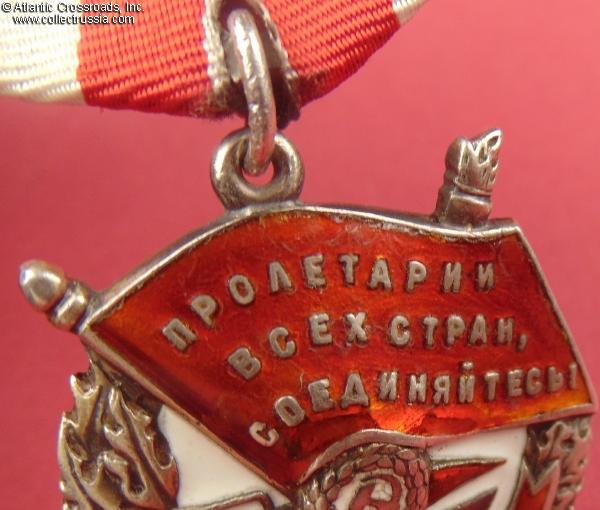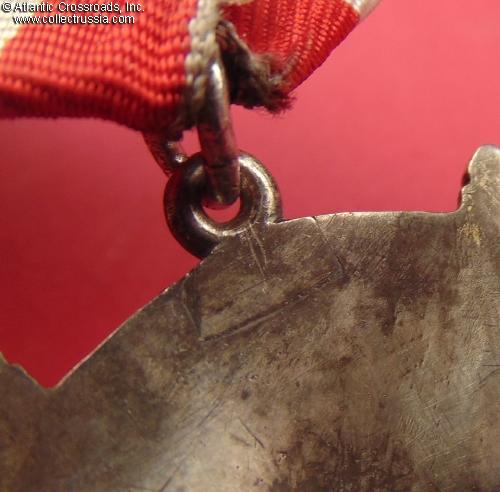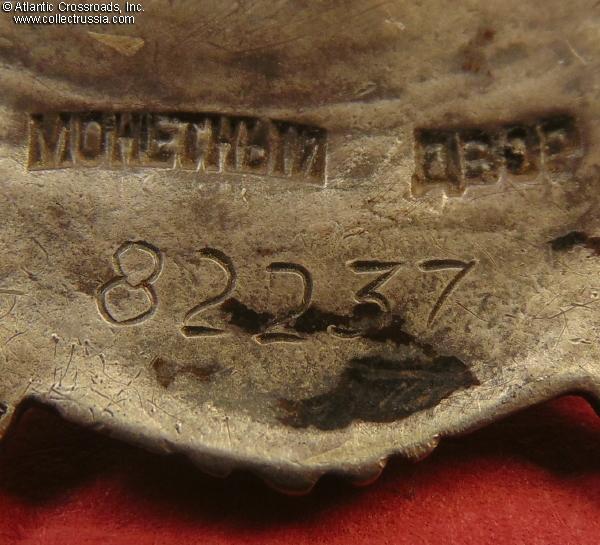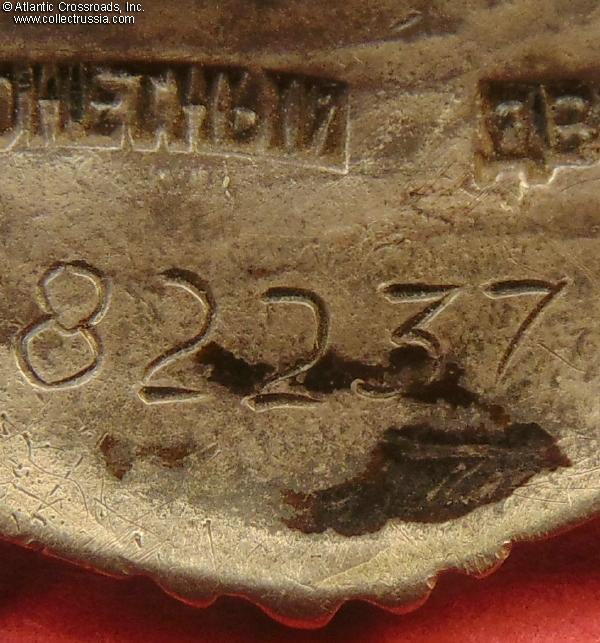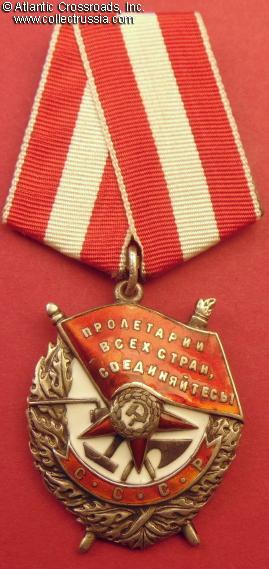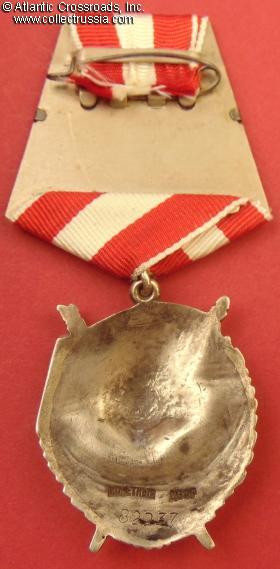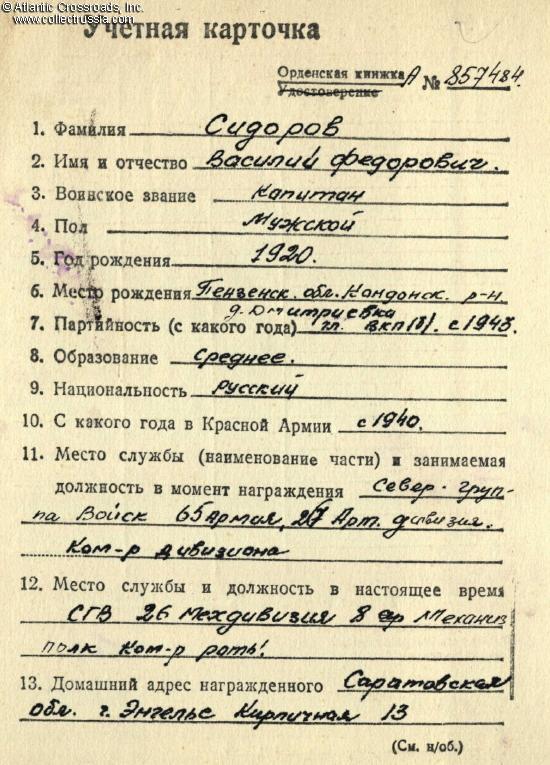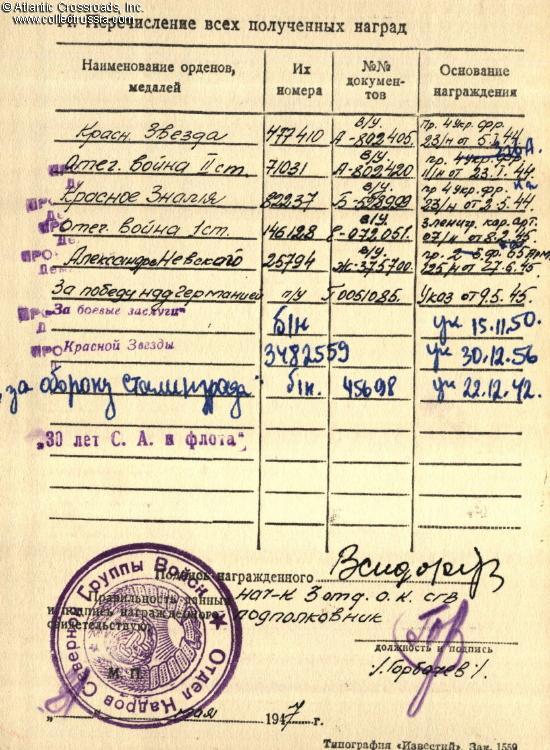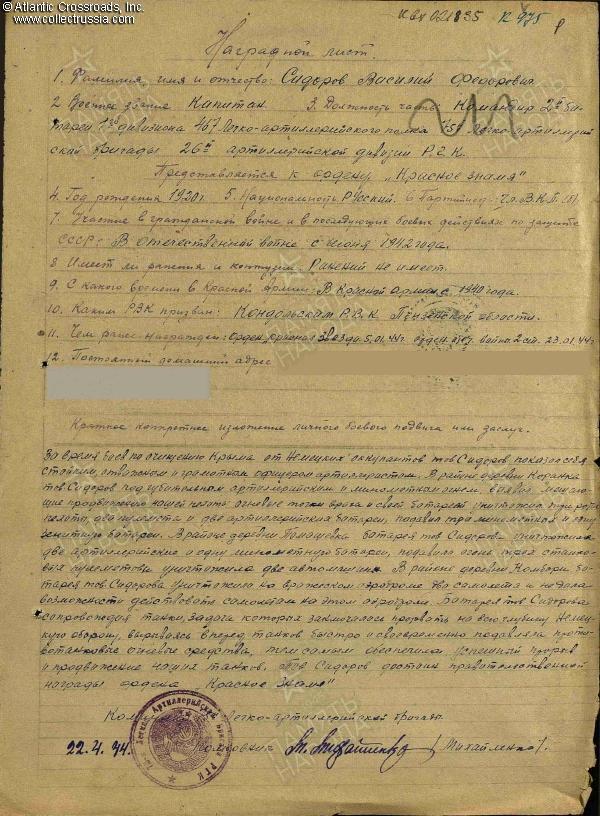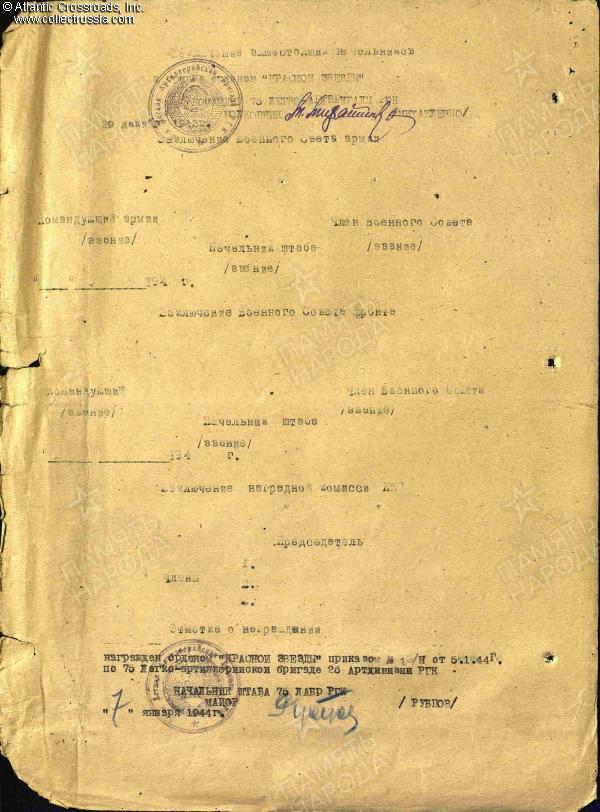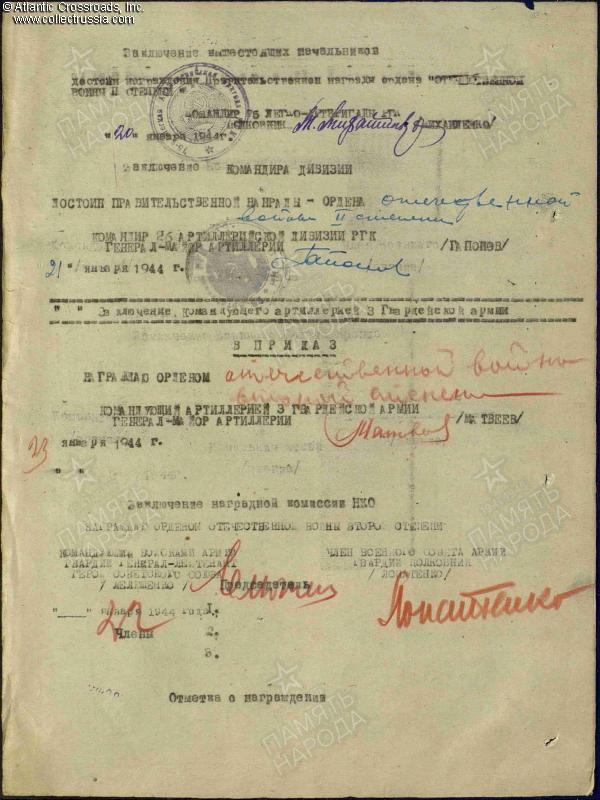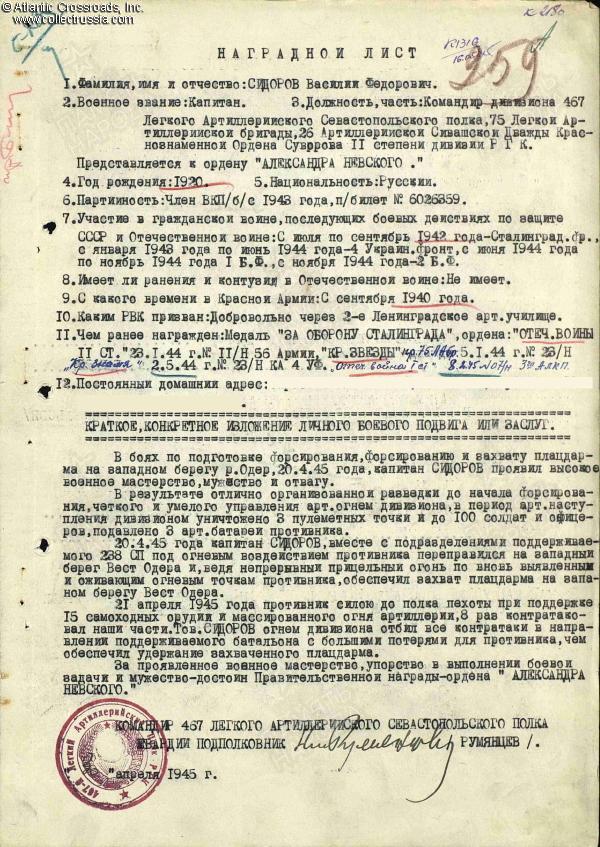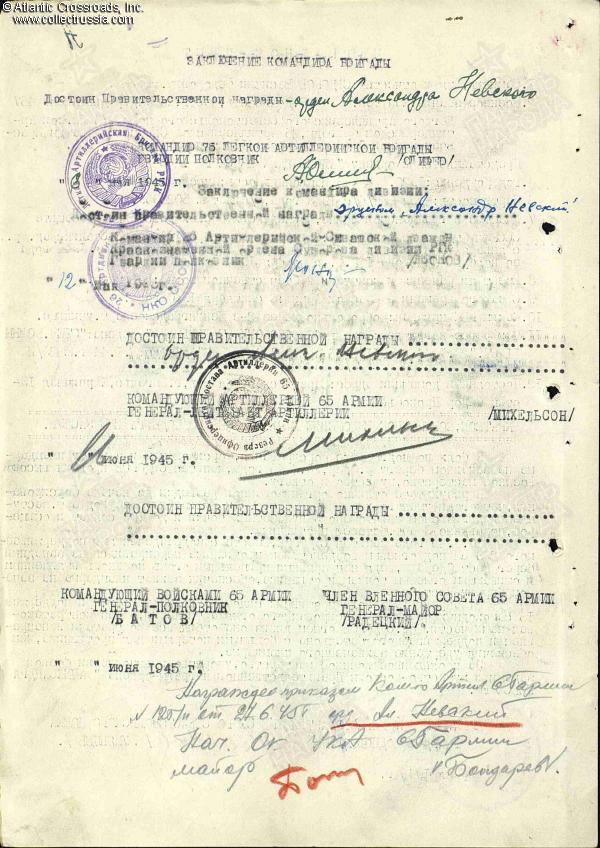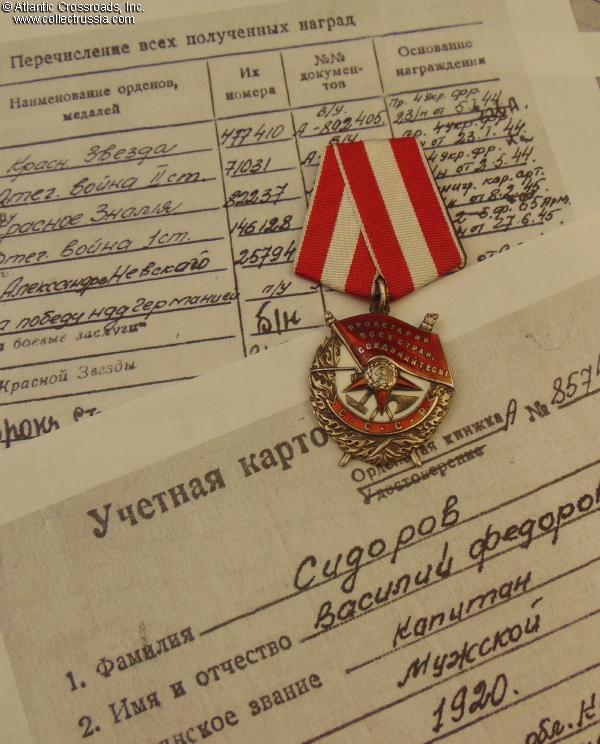Order of the Red Banner, Type 3, Variation 1, Sub-variation 2 "Swallow Tail" (Strekalov classification), #82237, awarded on 2 May 1945 to Captain Vasiliy Sidorov (Василий Федорович Сидоров), a battery commander with the 467th Light Artillery Regiment, 75th Light Artillery Brigade, 26th Artillery Division, Reserves of the Supreme Command.
Silver gilt, enamels. Measures 45.1 mm in height (incl. the eyelet and the lower extensions of the torch and flagpole), 36.9 mm in width; weighs 20.9 g not including the suspension and connecting link. This variation is transitional between Type 2 and Type 3, and its obverse is identical to Type 2 screw backs in high serial number ranges. The variation appeared immediately after the regulation change in June 1943. At that point the yet unfinished screw backs still in the production line were converted at the mint to suspension. This was achieved by inserting a small trapezoid-shaped wedge of silver to accommodate an eyelet for suspension. The wedge itself and the variation are often referred to as "swallow tail" or "lastochkin khvost" in Russian (the technically correct term would be dovetail, a carpenter's term for the interlocking joint which connects the two pieces of metal). This particular piece belongs to the first of the two "Swallow Tail" sub-variations, featuring a slightly arched first word of the mint mark. According to the published mint records, the serial number range for both sub-variations of the "Swallow Tail" is 79826 through 84250.
In fine condition. The red enamel is replaced on a narrow strip along the lower edge of the banner under the last line of writing and in an adjacent area extending approx. 7 mm in height along the flagpole and widthwise roughly to the second character of the last line of text. On the rest of the banner, there is surface flaking but no chips penetrating to silver. The enamel is also replaced on the right arm of the center star, while the other two arms are perfect. The red scroll near the bottom has some only some tiny surface flakes barely noticeable without magnification, otherwise intact. The white enamel has a microscopic amount of flaking in the center around the hammer & sickle emblem and is perfect in the outlying areas. The details of the wreath, flagpole and torch are well preserved and crisp; the original fire gilt, albeit pale, is present and clearly visible throughout.
The reverse shows attractive dark patina to silver, while some of the gilt "spillover" along its edge - a characteristic feature of late screw back and very early suspension issues - is still visible. Comes on an original wartime suspension device, a two-layer model is steel with self-locking pin. The ribbon is new. The silver connecting link has been cut but appears to be of the period. Overall, a very decent- looking example of the very scarce version of the Order of the Red Banner.
Vasiliy Sidorov was born in 1920 in a village of the Penza region of Russia. In September 1940, he started military service by enrolling in the 2nd Leningrad Artillery Officer School and during the Patriotic War, was on the front lines starting from the very beginning of the war in June 1941. In 1942 - early 1943 he took part in the Battle of Stalingrad.
Sidorov earned his first decoration of the war in December 1943 in action near the village of Shevchenko in southern Ukraine. At the time, he already had the rank of Captain and was serving as an artillery battery commander with the 467th Light Artillery Regiment, 75th Light Artillery Brigade, 26th Artillery Division, Reserves of the Supreme Command - the position he would occupy through the end of the war. From 19 - 23 December, during the efforts to completely clear the eastern bank of the Dnieper River, he was constantly at a forward observation post correcting artillery fire not only for his own regiment, but also other artillery units. His timely and skillful fire direction allowed to destroy two German artillery batteries, neutralize one artillery and two mortar batteries, and eliminate up to 200 enemy soldiers. Shevchenko's regiment commander subsequently recommended him for the Order of the Red Star which was awarded on 5 January 1944.
Within days, Capt. Sidorov distinguished himself again in the Korsun-Shevchenkovskiy Operation (aka the Battle of the Korsun Pocket.) On 14 January, he provided close fire support for the infantry in an assault 3 km northeast of the city of Korsun-Shevchenkovskiy. When the hard- pressed enemy desperately counterattacked, Sidorov replaced a killed rifle battalion commander and led the battalion in the defensive action, simultaneously directing the fire of his artillery squadron. He and his artillerymen rolled one of the guns in front of the infantry position, whereupon Sidorov personally manned the gun targeting the German tanks that posed the greatest threat. While repelling the counterattack, he set on fire three enemy tanks, destroyed three machine guns, and eliminated up to 30 enemy soldiers. For his bravery and leadership in the Battle of Korsun, on 23 January 1943 he was awarded with the Order of the Patriotic War, 2nd cl. - a seemingly low award considering his feat.
In April - May 1944, Sidorov's artillery division was assigned to the 51st Army, 4th Ukrainian Front, and took part in the liberation of the Crimean Peninsula. At the offset of the battle, the division advanced south from the previously acquired position on the Isthmus of Perekop, assisting the 51st Army in breaking through three heavily fortified German defensive lines. Sidorov's battery often accompanied Soviet tanks and, on many occasions, took position in front of the tanks to suppress enemy antitank weapons.
In one of the earlier skirmishes of the campaign, the 467th Light Artillery Regiment assisted the 417th Rifle Division in the storming of the settlement of Tomashevka (aka Tymashivka) which was an important anchor of the German and Romanian defenses in the northern part of Crimea. In this action Sidorov's battery destroyed two artillery batteries, one mortar battery, and two motor vehicles, and neutralized three heavy machine guns. Later, Sidorov under murderous fire detected locations of the enemy weapon nests near Karanki (aka Vlasovka, a now non-existent village that was located in the Ichkinskiy / Sovetskiy District of the arid and sparsely populated central-eastern part of Crimea). As a result of his actions, his battery eliminated three companies of enemy infantry, destroyed two machine guns and two artillery batteries, and suppressed three mortar batteries and one antiaircraft battery. It thus greatly contributed to the destruction of the group of Romanian troops, mostly of the 33rd Romanian Infantry Regiment, that had been isolated near Karanki.
In one of the most dramatic actions of its Crimean campaign, Sidorov's battery brought under fire an enemy airfield located near the village Kombori (another village that is mentioned in the award commendation but is apparently long since abandoned and cannot be found on any current map of Crimea.) Sidorov and his artillerymen managed to destroy two of the airplanes and denied the enemy any further use of the airfield. On 22 April 1944, well before the total Soviet victory in Crimea, Capt. Sidorov was recommended for the Order of the Red Banner by the commander of the 75th Light Artillery Brigade. The award was bestowed by an official decree of the Chief of Artillery of the 4th Ukrainian Front on 2 May 1944. It is worth mentioning that Sidorov's 4678th Light Artillery Regiment would soon be given the honorific title of Sevastopolskiy for its role in the liberation of Crimea and in particular, the storming of Sevastopol.
Sidorov earned his next decoration of the war in the Vistula - Oder strategic offensive. On 14 January 1945, the third day of the operation, the Soviet infantry advance near the village of Losewo in northeastern Poland west of Bialystok was stopped by two enemy artillery pieces and three machine guns. With complete contempt of mortal danger, Sidorov positioned his guns ahead of the forward line of the infantry and, while being himself exposed to machine gun and mortar fire, blasted the enemy weapons out of existence. His bravery greatly inspired his men and allowed the Soviet advance in the area to continue. On 8 February 1945, Sidorov was awarded for his heroic conduct in the Vistula-Oder Operation with the Order of the Patriotic War, 1st cl.
Sidorov's final award of WW2 was the Order of Alexander Nevsky (#25794), earned in April 1945 in the forced crossing of the Oder River. On 20 April, his squadron put to good use the reconnaissance data obtained under Sidorov's personal supervision ahead of the river crossing assault. During the artillery preparation, the squadron eliminated up to 100 German soldiers, destroyed three machine gun nests, and suppressed the fire of three artillery batteries. On the same day, he provided further support to the 238th Rifle Regiment helping it to capture a bridgehead on the West Oder, the western arm of the Oder River in its lower stream near Szczecin. On the following day, up to a regiment of enemy infantry counterattacked the newly captured Soviet position using 15 assault guns and massive artillery support. Sidorov and his men repelled all the counterattacks, inflicting heavy losses on the Germans and thus securing the bridgehead. On 27 June 1945, he was awarded for these actions with the Order of Alexander Nevsky by a general order of the 2nd Belorussian Front.
Sidorov remained on active duty for a long time after the war. In 1950, he was awarded with the Medal for Combat Service for the length of service and in 1956, with his second Order of the Red Star. As of 1947, still having the rank of captain despite having a large number of combat decorations, he commanded a company in the 8th Mechanized Regiment, 26th Mechanized Division.
Research Materials: photocopy of the award record card and award commendations for the five WW2 decorations, including the Order of the Red Banner.
Item# 43251
$1,750.00 Add to cart
